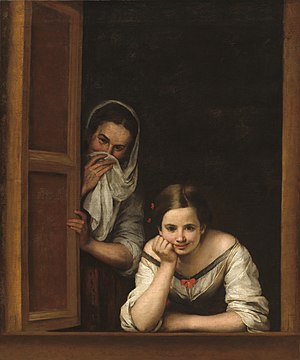More about Two Women at a Window
- All
- Info
- Shop

Contributor
Two Women at a Window is as straightforward as a title can get for a painting.
It tells you exactly what’s there. Nothing more. Nothing less. But that’s what makes it so realistic. If you walked by this painting at the National Gallery of Art in Washington DC, you might suddenly feel like you’re in the streets of Seville, Spain in the 1600s.
Bartolomé Esteban Murillo was one of the illest painters of his time. He was so dope that he continued to inspire artists like Thomas Gainsborough and Joshua Reynolds well into the 1800s. When Bart was doing his thing, Spanish artists were revered for their ability to bridge perceived reality to what was implied. This was a very religious time and people looked to painters and sculptors to convey their religious texts on canvas in a way that would help hammer home the messages within them. If you saw realistic humans interacting with angels that also looked like you, it would help make the stories within the bible feel more like events with real people. So because of that, it was like painters were the vessels of God himself. Sorry present day starving artists, you were born way too late.
However, Murillo’s realistic manner of representation wasn’t limited to religious scenes. He also liked to depict the everyday life of Seville on the canvas. From kids playing in the street to homeless beggars, the dude knew how to bring his hometown to life. That’s what makes Two Women at a Window so interesting. It’s not a painting of an angel or a clash of biblical titans, it’s just a couple of chicks looking outside.
But wait! You might be wondering what the girls are laughing at, then. Since we can’t see the street that they gaze onto, it really could be anything. A klutz dropping a box of oranges, a horse kicking it’s coachman, or you. Here’s a hint: It’s kind of you. Because of the way the painting is framed, the viewer is positioned to be what the girls are looking at. We stop to look at this on the wall and it’s like looking into a window into the past. It’s literally a slice of life. The only thing in the painting are the two women and the window frame. Their background isn’t detailed. And what lies in front of them is only implied, which makes the viewer an active participant of the scene. Murillo was so ahead of his time. This is some AP Photography stuff. But cameras weren’t even a thought when Murillo made this. That’s next level wizardry.
Either way, he must’ve had a pretty good sense of humor. Because these two girls have been laughing at every person that walks into their line of sight for the better part of 300 years. Murillo created such a clear scene...that just so happens to make us question the laws of time and space.
Sources
- Jones, Jonathan. “The Tomb Raiding Spaniard Who Cheated Death - Murillo: The Self Portraits Review” The Guardian. Accessed November 18, 2018. https://www.theguardian.com/artanddesign/2018/feb/28/murillo-self-portr…
- Sainsbury, Brendan. “What You Need to Know about Bartolomé Esteban Murillo, Master of the Spanish Baroque” Artsy. February 16, 2018. Accessed November 18, 2018. https://www.artsy.net/article/artsy-editorial-murillo-spent-200-years-s…
- The Art Story. “Bartolomé Esteban Murillo” Accessed November 17, 2018 https://www.theartstory.org/artist-murillo-bartolome-esteban.htm
Featured Content
Here is what Wikipedia says about Two Women at a Window

Two Women at a Window is an oil on canvas painting by Bartolomé Esteban Murillo, created in 1665–1675, now held in the National Gallery of Art in Washington, D.C., measuring 125 by 104 cm.
Its first recorded owner was Pedro Francisco Luján y Góngora, Duque de Almodóvar del Rio, whose heirs sold it to William A'Court in 1823. It remained in his family until being sold to an art dealer in 1894 and later that year by the dealer to Peter Arrell Browne Widener, who left it to its present owner in 1915.
Check out the full Wikipedia article about Two Women at a Window













